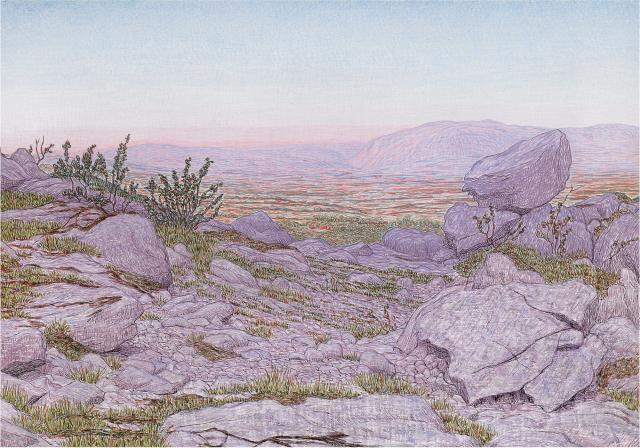A few boulders piled in a small heap, sparse vegetation poking out amongst the stones, a mountainous terrain in the distance: working from a seemingly simple motif, which is above all an arrangement of tones and forms, Alexandre Perrier manages to render the radiant impression of dawn rising over the landscape. Through the immense variety of its chromatic effects, Paysage rocheux (Rocky Landscape), dating from 1899, presents a nature whose bright glow is almost unreal, which the painter captures and sets down in its transience to better place it in a timelessness, recreating on the canvas his inner view of the landscape. Indeed, the artist didn’t paint from life but rather took his inspiration from the sketchbooks of drawings and pastels he filled as he wandered the countryside. He would then recompose his landscapes in the solitude of the studio.
After the foreground, which dominates the composition with its erratic blocks depicted in mauve and bluish shadows, a vast plain spreads out below, reaching to the sky, which seems to dissolve in a pink light. This slightly curved foreground emphasises the mountain in the distance and the misty atmosphere surrounding it. The stretch of landscape, the absence of any human life and the shadowy surface of the foreground help to lend the painting a feeling of great solitude and contemplative calm. Perrier eliminates from his work anything that might recall civilisation in order to create a world that is removed from human passions. He didn’t use Seurat’s pure tones or Segantini’s striated paint but did master a very subtle, almost threadlike pointillist brushstroke, which allowed him to achieve a transparency, as in the azure sky here mottled with a myriad of pink highlights, whilst imparting that impression of vastness and serenity.
After the foreground, which dominates the composition with its erratic blocks depicted in mauve and bluish shadows, a vast plain spreads out below, reaching to the sky, which seems to dissolve in a pink light. This slightly curved foreground emphasises the mountain in the distance and the misty atmosphere surrounding it. The stretch of landscape, the absence of any human life and the shadowy surface of the foreground help to lend the painting a feeling of great solitude and contemplative calm. Perrier eliminates from his work anything that might recall civilisation in order to create a world that is removed from human passions. He didn’t use Seurat’s pure tones or Segantini’s striated paint but did master a very subtle, almost threadlike pointillist brushstroke, which allowed him to achieve a transparency, as in the azure sky here mottled with a myriad of pink highlights, whilst imparting that impression of vastness and serenity.
